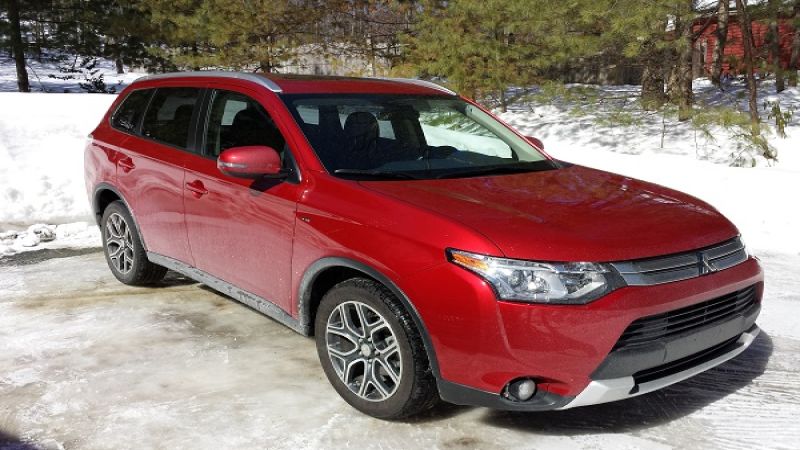The Toyota Highlander has grown considerably since its first generation. This is both good and bad. The newest Highlander was updated for 2014, and we put the vehicle through a full week of testing. The Mitsubishi Outlander doesn’t try to hide the fact that it is hoping that its name, look, and performance will remind you of the Highlander. Although the Outlander gives up 8 inches in length to the Highlander and about 4 inches in width, our testing reveals these two are worthy of comparison. Let’s look at what makes both of these great vehicles special.
2015 Mitsubishi Outlander 3.0 GT S-AWC
Is the Outlander “right-sized?” This writer thinks so. It is big inside for 5, able to carry 4 adults and three children if the rear jump seats are deployed, or can be configured as a “2+3” passenger with a huge cargo area. The Outlander is low for an SUV, almost like the Subaru Outback (hmm, that name sounds familiar too). That is a plus since the Outlander is tall enough to allow drivers to see over snowbanks, but not so high up that it is tippy.
The Outlander also has an excellent drivetrain. The 3.0-liter V6 develops plenty of power and the 6-speed transmission shifts perfectly. The vehicle always seems to be in the right gear. During my testing, I set the drivetrain to “ECO” mode and never felt like I lacked for power. The “Super All-Wheel Control (S-AWC)” all-wheel drive system works flawlessly in my driveway, which was a hilly, 208 foot ice luge during the week of my test. I could stop the Outlander on the hill on a sheet of wet ice and then restart my progress easily.
I’d score the drivetrain in the Outlander a 10, except for one drawback. It needs premium fuel. Boo! Make it a 9. That said, my fuel efficiency (if not economy) was excellent. The Outlander is EPA-rated at an estimated 23 MPG combined, 20 city, and 28 highway. In combined driving, I did better than the rated estimate.
The Outlander provides a good ride with decent handling. This is not a car, nor is it an off-road vehicle like a Jeep Grand Cherokee. It splits the difference just like the Outback and Highlander do. The 18” wheels were not super low profile, which I saw as a plus given the terrible conditions of our roads these days. Bumps are handled with comfort and cornering is good.
Inside, the Outlander is clean and open. The leather seats that come with the GT Touring package are comfortable and have heat and power. The layout is simple to use, and everything has a place. There is a perfect phone cradle ahead of the shifter in the dash, and the cupholders are well-placed. HVAC is relatively easy to use, and the 7” infotainment screen is in a good spot for the driver to touch it. Unfortunately, I have to say that this system is not that easy to use. I had trouble synching my phone, and I consider myself an expert in doing that. During my test of the Outlander, Daylight Savings time required that I change the clock. It took me 5 minutes. That is exactly 4 minutes and 58 seconds longer than it would take in the Highlander. The Rockford Fosgate stereo with its huge speaker in the cargo area also was unimpressive.
With a price of just $35,145 with the full safety suite, including forward collision prevention and radar cruise control, I would call this Outlander a fair deal. The Outlander I drove earned the Top Safety Pick Plus rating from the IIHS, and there is no higher safety standard than that.
Toyota Highlander XLE
My XLE Highlander tester had three rows of seats with the middle bench and rear row having three spots. Thus, it is an 8-passenger vehicle. It can also come with captain’s chairs in the middle row making it a 7-passenger. Either way, the last row is big. If you plan to use that row a lot, this is a plus. On the other hand, if you plan to use that a lot why not an AWD Sienna minivan?
The Highlander is surprisingly good in the handling department. It is better than the two prior generations though not as “tossable” or maneuverable as the shorter-wheelbase Highlanders that ended in 2007. The updated interior shines in all areas. Our full review of the Highlander revealed that Toyota does all the small things right. The Toyota also has abundant real-world usable storage up front.
Highlanders are class competitive for fuel economy. It’s EPA-estimated fuel economy is 18 MPG city/ 24 highway/ 20 combined. In my summer testing, I achieved 24 MPG in mixed driving. In this comparison that is pretty good considering the Highlander uses regular and the Outlander uses premium.
The Highlander’s growth has brought the vehicle to the extremes of the “mid-sized” SUV category. With the RAV4 being a compact, and this Highlander being so large, vehicles like the Outlander start to look very attractive to shoppers that want a “4+3” vehicle. One that is roomy for four but can act as a car-pool vehicle for kids’ soccer when need be.
Both the Toyota Highlander and Mitsubishi Outlander are safety standouts. The Highlander with the same level of equipment as the $35 K Outlander will top $40K. Both are offered at fair prices, neither at what one would consider a discounted MSRP. The question really is how much space do you need, and how much do you value Toyota’s gold-standard reputation for quality, durability, and reliability?
Authors’ Note: The author owns a 2007 Highlander. Any bias in the story is unintentional, but it should be noted that over 8 years this vehicle has proven utterly reliable.












